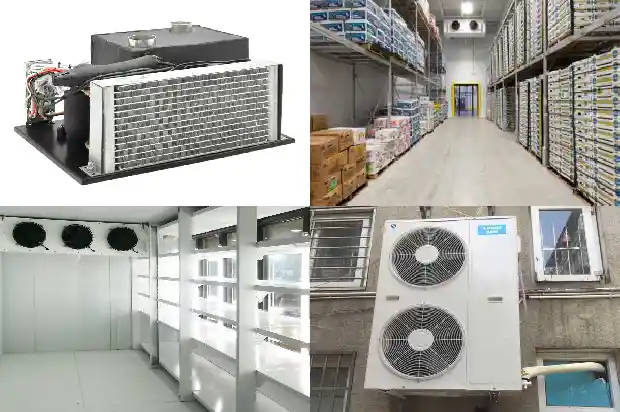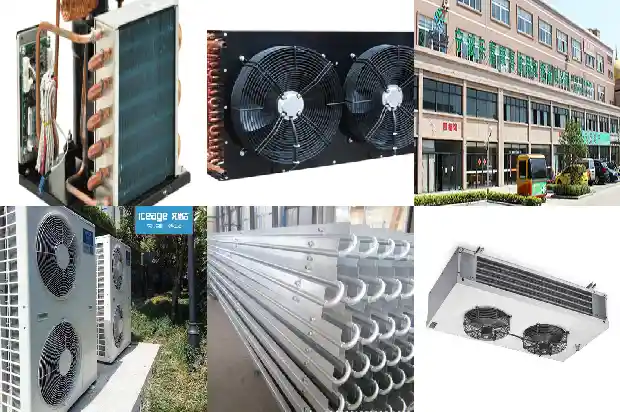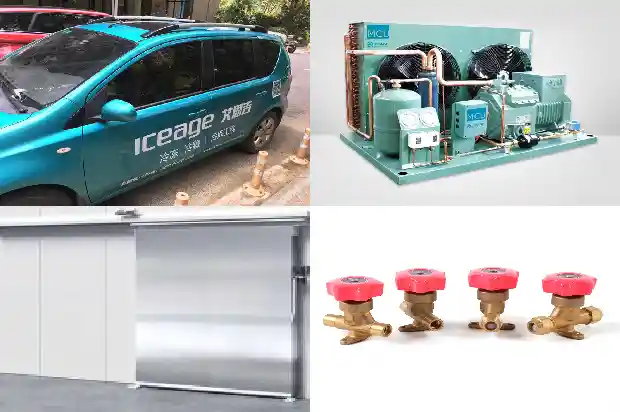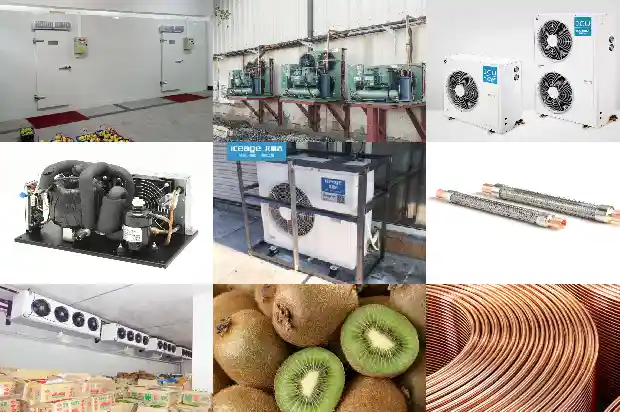Working Principle and Characteristics of Screw Compressors
2025-03-14
Introduction to Screw Refrigeration Compressors:
The screw refrigeration compressor is also known as the screw compressor. In the 1950s, oil - injected screw refrigeration compressors were applied in refrigeration units. Due to its simple structure, few vulnerable parts, low exhaust temperature under working conditions with large pressure differences or pressure ratios, insensitivity to a large amount of lubricating oil in the refrigerant (often called a wet stroke), and good regulation of gas delivery volume, it quickly occupied the application range of large - capacity reciprocating compressors and continuously extended to the medium - capacity range. It is widely used in refrigeration units such as refrigeration, cold storage, air - conditioning, and chemical processes. The screw heat pump with it as the main unit has been used in heating and air - conditioning since the early 1970s, including air - source type, water - heat - pump type, heat - recovery type, ice - storage type, etc. In the industrial field, in order to save energy, screw heat pumps are also used for heat recovery.
The screw refrigeration compressor is also known as the screw compressor. In the 1950s, oil - injected screw refrigeration compressors were applied in refrigeration units. Due to its simple structure, few vulnerable parts, low exhaust temperature under working conditions with large pressure differences or pressure ratios, insensitivity to a large amount of lubricating oil in the refrigerant (often called a wet stroke), and good regulation of gas delivery volume, it quickly occupied the application range of large - capacity reciprocating compressors and continuously extended to the medium - capacity range. It is widely used in refrigeration units such as refrigeration, cold storage, air - conditioning, and chemical processes. The screw heat pump with it as the main unit has been used in heating and air - conditioning since the early 1970s, including air - source type, water - heat - pump type, heat - recovery type, ice - storage type, etc. In the industrial field, in order to save energy, screw heat pumps are also used for heat recovery.
Working Principle of Screw Refrigeration Compressors:
Inside the cylinder of a screw compressor, there is a pair of meshing spiral male and female rotors. Both rotors have several concave teeth and rotate in opposite directions. The gaps between the rotors and between the casing and the rotors are only 5 - 10 silk. The main rotor (also known as the male rotor or convex rotor) is driven by an engine or an electric motor (mostly an electric motor), and the other rotor (also known as the female rotor or concave rotor) is driven by the oil film formed by oil injection from the main rotor, or by the synchronous gears at the ends of the main rotor and the concave rotor. So there is no metal - to - metal contact (theoretically) during the driving process.
The length and diameter of the rotors determine the exhaust volume (flow rate) and exhaust pressure of the compressor. The longer the rotors, the higher the pressure; the larger the rotor diameter, the larger the flow rate.
The grooves of the screw rotors are filled with gas when passing through the suction port. When the rotors rotate, the rotor grooves are sealed by the casing wall, forming a compression chamber. After the rotor grooves are sealed, lubricating oil is sprayed into the compression chamber to play the roles of sealing, cooling, and lubrication. When the rotors rotate to compress the lubricant - gas mixture (abbreviated as the oil - gas mixture), the volume of the compression chamber decreases, and the oil - gas mixture is compressed towards the exhaust port. When the compression chamber passes through the exhaust port, the oil - gas mixture is discharged from the compressor, completing an intake - compression - exhaust process.
Each rotor of the screw machine is supported by antifriction bearings, and the bearings are fixed by end covers near the end of the shaft. The intake end is supported by roller bearings, and the exhaust end is supported by a pair of tapered roller bearings. Usually, the bearings at the exhaust end position the rotor, that is, the thrust bearings, which resist axial thrust, bear radial loads, and provide the necessary minimum axial running clearance.
The working cycle can be divided into three processes: intake, compression, and exhaust. As the rotors rotate, each pair of meshing teeth successively completes the same working cycle.
Inside the cylinder of a screw compressor, there is a pair of meshing spiral male and female rotors. Both rotors have several concave teeth and rotate in opposite directions. The gaps between the rotors and between the casing and the rotors are only 5 - 10 silk. The main rotor (also known as the male rotor or convex rotor) is driven by an engine or an electric motor (mostly an electric motor), and the other rotor (also known as the female rotor or concave rotor) is driven by the oil film formed by oil injection from the main rotor, or by the synchronous gears at the ends of the main rotor and the concave rotor. So there is no metal - to - metal contact (theoretically) during the driving process.
The length and diameter of the rotors determine the exhaust volume (flow rate) and exhaust pressure of the compressor. The longer the rotors, the higher the pressure; the larger the rotor diameter, the larger the flow rate.
The grooves of the screw rotors are filled with gas when passing through the suction port. When the rotors rotate, the rotor grooves are sealed by the casing wall, forming a compression chamber. After the rotor grooves are sealed, lubricating oil is sprayed into the compression chamber to play the roles of sealing, cooling, and lubrication. When the rotors rotate to compress the lubricant - gas mixture (abbreviated as the oil - gas mixture), the volume of the compression chamber decreases, and the oil - gas mixture is compressed towards the exhaust port. When the compression chamber passes through the exhaust port, the oil - gas mixture is discharged from the compressor, completing an intake - compression - exhaust process.
Each rotor of the screw machine is supported by antifriction bearings, and the bearings are fixed by end covers near the end of the shaft. The intake end is supported by roller bearings, and the exhaust end is supported by a pair of tapered roller bearings. Usually, the bearings at the exhaust end position the rotor, that is, the thrust bearings, which resist axial thrust, bear radial loads, and provide the necessary minimum axial running clearance.

The working cycle can be divided into three processes: intake, compression, and exhaust. As the rotors rotate, each pair of meshing teeth successively completes the same working cycle.
Advantages of Screw Refrigeration Compressors:
- High reliability. Screw compressors have few components and no vulnerable parts, so they operate reliably with a long lifespan. The interval between major overhauls can reach 40,000 - 80,000 hours.

- Easy operation and maintenance.
- Good power balance. It is especially suitable as a mobile compressor, featuring small size, light weight, and a small footprint.
- Strong adaptability.
Screw compressors have the characteristic of forced gas delivery, and their volumetric flow rate is hardly affected by the exhaust pressure. They can maintain high efficiency within a wide range. Without any changes to the compressor structure, they are suitable for various working fluids.
- Multiphase mixed transportation. There are actually gaps between the tooth surfaces of the rotors of screw compressors, so they can withstand liquid impacts and can transport gas containing liquid, gas with dust, and polymerizable gases.
Disadvantages of Screw Refrigeration Compressors:
- High cost. Since the tooth surface of the rotor of a screw compressor is a spatial curved surface, special tools are required for processing on expensive special equipment. In addition, there are also high requirements for the machining accuracy of the cylinder of the screw compressor.

- Not applicable to high - pressure applications. Due to limitations in rotor stiffness and bearing life, screw compressors can only be used in the medium - and low - pressure ranges, and the exhaust pressure generally does not exceed 3 MPa.
- Not applicable to micro - scale applications. Screw compressors rely on gaps to seal gas. Generally, only when the volumetric flow rate is greater than 0.2 m³/min can screw compressors exhibit superior performance.
Related Articles
- HVAC - Concise Explanation of Refrigeration Principles
- Working Principle and Daily Maintenance of Water-based Machines
- Analysis of the Working Process and Principle of Hot Fluoride Defrosting for Air Coolers
- Principles and Applications of Common Pressure Control and Pressure Regulating Valves
- Screw Compressor Units: Principles, Design and Selection - Essential Guide for Refrigeration Beginners
- Principles, Components and Heat Recovery of Modular Units
- What are Refrigeration Equipment? What's the Principle of Chillers?
- What Is the Working Principle of Refrigeration Equipment?
- Operating Principle and Standard Installation Steps of Multi - split Systems in Refrigerant Air - conditioning Systems
- Working Principle of AC Inverter and DC Inverter Air Conditioners
- What's the principle and function of air energy?
- Principles of Refrigeration Systems and Functions of Components Explained
- Working Principle and Control Logic of Centrifugal Compressor
- Function and Working Principle of Subcooler
- Fault Analysis of Working Principle of Screw Chiller Unit
- Working Principle of Economizer for Refrigeration Compressor
- Principle of Multiple Storages in One Unit and Evaporation Pressure Regulation Methods
- Principle and Refrigeration Process of Piston Refrigeration Compressor
